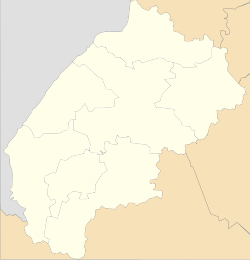Skole
Skole
Сколе | |
|---|---|
City | |
 Church of the Nativity of Blessed Virgin Mary in Skole | |
 | |
| Country | |
| Province | |
| District | |
| First mentioned | 1397 |
| Population (2013) | |
| • Total | 6,312 |
| Time zone | UTC+2 (EET) |
| • Summer (DST) | UTC+3 (EEST) |
Skole (Ukrainian: Ско́ле) is a town in Lviv Oblast (region) of Ukraine. It is the administrative center of Skole Raion. Population: 6,312 (2013 est.)[1].
History
The first official date recorded for Skole was in 1397. A very important route from Kyiv to Hungary ran through Skole; as a result, it was frequently fought over by other nations. When the Skole region was under Polish rule, the Polish king parceled out the land among the Polish nobility. German colonists, particularly craftspeople, who settled in the Skole region promoted the development of it economy. A great influence on the economy and cultural development of the region was Baron Groedl and his family. In Skole, the coins of Baron Groedl were used. They were minted at Vien, a mint which continued to be in use until 1930.
Skole received its Magdeburg rights in 1397, by a decree of King Wladyslaw Jagiello. Until 1772, the town belonged to the Lwow Land, Ruthenian Voivodeship of the Kingdom of Poland. Following the Partitions of Poland, it was annexed by the Habsburg Empire, as part of Austrian Galicia, where Skole remained until 1918. In the interbllum period, it was part of Stryj County, Stanislawow Voivodeship, with population divided between Jewish, Polish and Ukrainian communities, also Germans and Czechs. In its vicinity there were three German villages, Annaberg, Felizienthal and Karlsdorf. Until September 17, 1939 (see Soviet Invasion of Poland), the town housed Battalion Skole of the Border Protection Corps.
Modern Skole is a small town at the center of Skole district, with favorable conditions for the tourist trade.
Architecture
In the city has two monuments of cultural heritage in Ukraine.
- Church of St.Paraskeva (wooden) 17th century.
- The bell tower of the church St.Paraskeva (wooden) 1760.
- Church of the Nativity Blessed Virgin Mary
Gallery
-
Church and the bell tower of the church St.Paraskeva
-
Church of St.Paraskeva (wooden) 17th century
-
The bell tower of the church St.Paraskeva (wooden) 1760
-
The cross near of the church St.Paraskeva
-
Groedel family palace in Skole
-
Downtown Skole
-
Magnates' houses in Skole
Region

- The area of the Skole Raion is 1,474 km2 (569 sq mi).
- The population is 50,188 persons.
- The district consists of 57 villages.
There are many notable places in the Skole region. The village of Grebeniv, for example, was once renowned for its sanitarium where Metropolit Sheptytskyy and prime minister Cherchel were treated. Verchne Synevydne is the first remembrance in the Galician–Volhynian Chronicle (1240). This history is concerned with the person of Danylo Galytskyy.
Skole is the birthplace of Polish politician Stanislaw Glabinski and writer Beata Obertynska.
Tustan'
About 25 million years ago in the Neogene period of the Cenozoic era, the sandstone Carpathian mountains were formed. Some of them emerged on the Earth's surface. In geology they are known as Iamna sandstone (named for the village of Iamna). The complex consists of Kamin’ (stone), Ostryy Kamin’ (sharp stone), Mala Skelia (small rocks), Zholob (gutter). In some places sandstone formed into monoliths, and in other places as chaotic rocks. There are many cracks, burdens and caves; some man-made.
The sandstone was subject to erosion, creating exotic shapes (“Chotyry Veletni” or Four Giants, “Try Pal’tsi” or Three Fingers, “Chotyry Spysy” or Four Lances, and “Orel” or Eagle); there are many myths and legends pertaining to these rock formations.
In 3000 BC a sanctuary was built on these rocks. Scientists discovered 270 petroglyphs. From the 9th to the 13th centuries, the fortress of Tustan' existed on these rocks. 4,000 grooves[clarification needed] and glades have been discovered. An outline of the fortifications has been reconstructed at the site.
The sandstone in Urych is a natural phenomenon with scientific, recreational, aesthetic, historical and cultural value. At present the Tustan' sandstone formations is a state history and cultural reserve visited every year by more than 3,000 people.
People from Skole
- Yaroslav Koshiv — an Ukrainian journalist[2][3]
- Stepan Okhrymovych — a member of the Ukrainian nationalist movement, the leader of the Organization of Ukrainian Nationalists in Western Ukraine
- Stanisław Głąbiński — a Polish politician, academic, lawyer and writer.
- Nataliya Obmochaeva — a Russian volleyball player.
See also
Notes
- ^ Чисельність наявного населення України [Actual population of Ukraine] (in Ukrainian). State Statistics Service of Ukraine. Archived from the original on 2014-02-02. Retrieved 21 January 2015.
- ^ Koshiv Yaroslav
- ^ Yaroslav Koshiv lecture in Washington, DC
External links
- Skole in Ukrainian language
- skoletown.net.ua (Ukrainian non-official page)
- Hotel restaurant "Vivcharyk" (ukr, rus, eng)
- Skole Region in Ukrainian language, page UYC - Ukrainian Youth for Christ in Skole









